Shark Week 2018 is upon us. And to honor our favorite apex predators, Scuba Diver Life is going to publish content all week focused exclusively on sharks, from a shark-tooth identification quiz, to which shark-conservation organizations you should support with your time and money. But since divers are most eager to actually get in the water with sharks, here’s our definitive list of the world’s top 20 shark dives.
1. Great white sharks
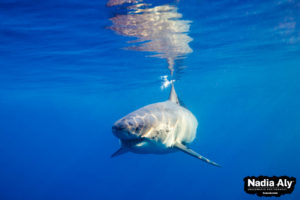
What diver doesn’t want to see a great white underwater? Growing up to 20 feet (6 m) long and living in all the major oceans, an encounter with great whites should be on everyone’s bucket list.
Where: Guadalupe Island, Mexico
Guadalupe Island is the premier destination for great white shark cage-diving for two reasons: the relatively warm water and great visibility. Such great conditions make it easy to spend plenty of time in the water without getting cold and offer the best chance to see the sharks clearly both up close and from afar.
Details: Water temperatures during shark season range from 66 to 71 F (19 to 22 C). Visibility ranges from 140 to 160 feet (42 to 50 m). It can get chilly when cage diving, as you don’t move much in the cage. Choose a wetsuit of at least 5mm, plus gloves and a hood. You don’t need any experience to cage dive at Guadalupe — you needn’t even be a certified diver for the surface cage. If you are certified, however, you can spend time in the cage both at depth and on the surface. The Nautilus Explorer offers 5-night shark-diving safaris from July to November each year.
When to go: The best time to visit depends on which sharks you want to dive with. The energetic male sharks visit during July and August each and the huge females that Guadalupe is famous for arrive in October and November.
2. Scalloped hammerhead sharks
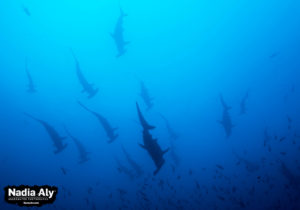
Scalloped hammerhead sharks are known for schooling in vast numbers. Your best bet for an encounter is in one of two idyllic dive destinations: the Galapagos Islands or Cocos Island. Here we’ll focus on Cocos, as the Galapagos will make appearances further down our list.
Where: Cocos Island, Costa Rica
UNESCO World Heritage site Cocos Island offers sublime diving. Ocean currents attract hundreds of scalloped hammerheads, as well as mantas and whale sharks. Some of the best dive sites for schooling hammerheads are Alcyone, Dirty Rock, Manuelita, and Submerged Rock.
Details: Water temperatures are consistent all year, ranging from 75 to 82 F (24 to 28 C), though colder thermoclines are common. Visibility varies widely but can reach up to 80 feet (25 m). Take a hood, gloves and booties and suit up in at least a 5mm full wetsuit.
When to go: May to November is the best time for huge schools of hammerhead sharks.
3. Tiger sharks
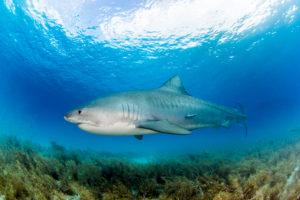
Tiger sharks can grow up to 17 feet (5 m) long and are one of the most instantly recognizable sharks to dive with. They often approach divers closely as well, offering great photographic opportunities.
Where: Tiger Beach, The Bahamas
Tiger Beach is unbeatable for numerous tigers and crystal-clear, warm water. There’s almost no current, and the dive site is relatively shallow, sandy, and easy to dive. Divers can see up to 15 tigers at any one time plus lemon sharks, nurse sharks, and Caribbean reef sharks.
Details: Water temperatures range from 77 to 86 F (25 to 30 C) and depth varies from 20 to 100 feet (6 to 30 m). Some operators ask for an Open Water certification and 30 logged dives, though some require less experience. The Bahamas Master offers 7-night Tiger Beach safaris and requires an Open Water certification and just four logged dives.
When to go: The tiger sharks are here all year, though October to January is the best time for the most sharks. July to August has the least amount of tiger sharks.
4. Grey reef sharks
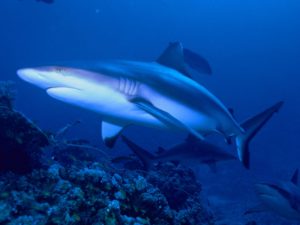
Grey reef sharks often congregate in large numbers at coral reef drop-offs and make for thrilling shark encounters.
Where: Tiputa Pass, French Polynesia
Tiputa Pass at Rangiroa is well-known for its exciting grey reef-shark dive. A forceful current washes through the pass during the incoming tide, which gives divers the chance to hook in and see a wall of numerous grey reef sharks. Once you unhook, you’ll fly into the lagoon in the current.
Details: Water temperatures range from 75 to 82 F (24 to 28 C) and dive depth is around 100 feet (30 m). French Polynesia’s dive regulations are strict, and divers must be Rescue certified to dive beyond 30 m, regardless of whether they have a Deep Diver specialty.
When to go: Scuba diving is possible all year. January through March are the warmest, most humid months, with a water temperature of around 82 F (28 C). It is drier from July through November, with water temps around 75 F (24 C). The reef sharks are present all year.
5. Oceanic whitetip sharks
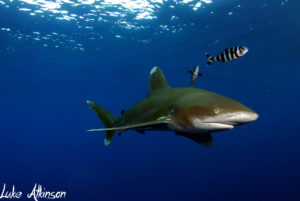
Oceanic whitetip sharks are large, confident and curious about divers. You can easily recognize them by their white-tipped, rounded pectoral fins.
Where: Elphinstone reef and the Brothers, Egypt
Egypt is a great destination for encounters with oceanic whitetip sharks, especially at the Brothers and Elphinstone reef. The Brothers, with their steep drop-offs and beautiful corals, offer the chance to dive with oceanic whitetips, reef sharks, hammerheads and even occasional thresher sharks in winter. The long reef of Elphinstone has spectacular drop-offs and great spots for encounters with oceanic whitetips, hammerheads and even whale sharks.
Details: Water temperatures range from 70 to 86 F (21 to 30 C). Visibility is typically around 60 to 100 feet (20 to 30 m). The strong currents and deep drop-offs make diving the Brothers and Elphinstone more suitable for experienced divers. The Emperor Fleet offers a variety of safaris and liveaboards that visit both areas.
When to go: September to November and April to June are the best times to see oceanics at both locations.
6. Whale sharks
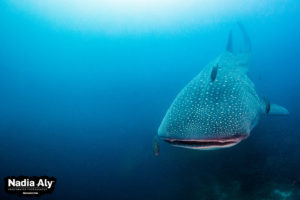
The instantly recognizable whale shark is one of the easiest to dive with, and you’ll find them at various dive destinations.
Where: The Maldives
The best spots for whale-shark encounters are Ari Atoll, as well as Huvadhoo and Thaa atolls in the south. Ari is a popular liveaboard destination, while the remote southern atolls have great shark action with very few boats around. Divers can see whale sharks, silky sharks, hammerheads and grey reef sharks, plus spend time lagoon and channel diving.
Details: Water temperatures are consistent in the Maldives, ranging from 79 to 84 F (26 to 29 C), though it does drop down to 75 F (24 C) in the far south during the northeast monsoon. Water visibility can reach 100 feet (30 m). The Duke of York liveaboard offers seven-night “Extreme South” safaris to explore Huvadhoo during February and March.
When to go: The Maldives has two distinct seasons. December to May (the northeast monsoon) has calm waters and better water visibility on the eastern side of the atolls. The southwest monsoon mirrors the northeast conditions, having cloudier weather and less calm seas. Whale sharks are present year-round.
7. Silky sharks
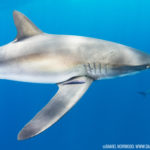
Silky sharks inhabit tropical waters around the world, including one of the world’s top dive destinations.
Where: The Galapagos Islands
Atop most all divers’ bucket lists, the huge variety of marine life in the Galapagos does not disappoint. Most famous for shark encounters are iconic Wolf and Darwin islands, accessible only via liveaboard. These remote, uninhabited islands offer the chance to dive with large groups of silky sharks, hammerheads, Galapagos sharks, mantas, whale sharks and more.
Details: Water temperatures in Galapagos range from 60 to 77 F (16 to 25 C). Water visibility is generally 30 to 70 feet (10 to 21 m). Strong currents and swells, especially at Wolf and Darwin, can make diving challenging. Divers can expect negative entries at these sites and gloves are absolutely necessary for holding onto barnacle-covered rocks. Galapagos diving is best for experienced divers with a minimum of 50 logged dives, though there are some sites suitable for less-experienced divers. The Galapagos Master offers seven and 10-night safaris year-round.
When to go: The warm season of January to May is a great time of year to see large numbers of silky sharks, though you can also see them during the cooler months of June to December — the peak diving season for whale sharks.
8. Galapagos sharks
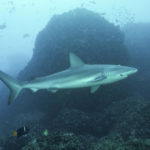
Contrary to their name, Galapagos sharks live around the world in tropical oceans. These beefy yet graceful sharks often reach 10 feet long (3 m).
Where: The Galapagos Islands
There are plentiful Galapagos sharks in the Galapagos, including at Wolf and Darwin Islands. Punta Carrion on Santa Cruz is a favorite site to spot these sharks in relatively easy conditions and makes for a good introduction to Galapagos diving as well. Most of the action is between 40 and 60 feet (12 to 18 m), allowing divers plenty of bottom time to enjoy a variety of sharks as well as mobula rays, sea lions and other fish life.
Details: Water temperatures in Galapagos range from 60 to 77 F (16 to 25 C) and visibility is generally 30 to 70 feet (10 to 21 m). Strong currents and swells can make diving challenging, so this location is best for experienced divers with a minimum of 50 logged dives. Some sites, though, are suitable for less-experienced divers. The Galapagos Sky offers 7-night safaris all year.
When to go: The warm season of January to May is a great time of year to see lots of Galapagos sharks, though you can also see them in fewer numbers during the cooler season of June to December.
9. Thresher sharks
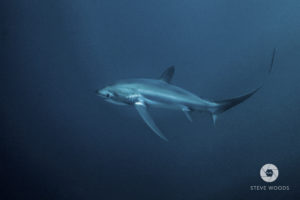
The elusive thresher shark rarely ventures up from the depths and there is only one place in the world with reliable thresher-shark dives.
Where: Malapascua, the Philippines
Graceful thresher sharks, with the scythe-like tails, are the main attraction at Monad shoal off Malapascua Island. Divers splash in before dawn to see the sharks there almost every day at cleaning stations. Threshers also visit Kimud shoal, but in fewer numbers and not quite as reliably as at Monad.
Details: Water temperatures range from 75 to 84 F (24 to 30 C), and visibility is generally around 100 feet (30 m). Monad shoal diving is best for experienced divers, as you’ll descend to around 82 feet (25 m) at least to see the sharks. Nitrox certification is best to make the most of the thresher-shark dives. The Philippine Siren offers 10-night safaris to Malapascua from July to February each year.
When to go: You can dive at Monad year-round. Threshers are there all year and hammerheads peak in March and April.
10. Bull sharks
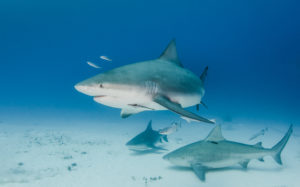
Bull sharks might have a reputation as aggressive but they’re actually easy to dive with, relaxed and confident as they pass divers at close range.
Where: Playa del Carmen, Mexico
This is one of the best bull-shark dives in the Americas. Divers can encounter up to 20 sharks at once and see large female bull sharks, which congregate in the area to breed. The dive site is easily accessible via 15-minute boat ride from shore and features a sandy bottom in clear water.
Details: Water temperatures range from 77 to 82 F (25 to 28 C) and stay fairly constant all year. Different operators offer various dives and there are options for both OW and AOW divers. Depths range from 60 to 79 feet (18 to 24 m).
When to go: The bull sharks are present at Playa del Carmen from November to March each year.
11. Great hammerhead sharks
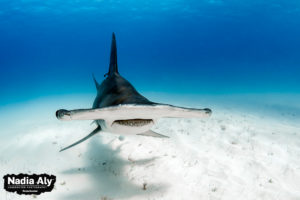
Great Hammerhead sharks can grow up to 20 feet long (6 m) and live in clear, tropical waters, perfect for warm-water diving.
Where: Bimini, The Bahamas
Great hammerheads gather in large numbers each winter in Bimini, Bahamas, coming quite close to divers as they glide by. Crystal-clear waters, bright-white sand and great visibility make this one of the world’s best spots for observing, as well as photographing, great hammerheads. It is also a great destination for bull shark encounters.
Details: Water temperatures range from 75 to 88 F (24 to 31 C) and stay fairly constant all year. Hammerhead shark dives at Bimini are suitable for new divers with Open Water certification and only four logged dives, as they’re conducted in no more than 30 feet (10 m) of water.
When to go: The hammerhead sharks are present from December to March each year.
12. Sand tiger sharks
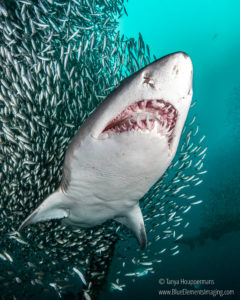
Sand tiger sharks, or raggies as they’re also known, might look ferocious with their pointed teeth but they’re docile and quite sedate during a dive.
Where: North Carolina, United States
The Outer Banks of North Carolina are a top location for shark dives and the area is peppered with shipwrecks. These wrecks have developed into thriving reefs with numerous sand tiger sharks, plus blacktip, sandbar and bull sharks as well. Divers can see over 50 sand tiger sharks during a dive.
Details: Summer water temperatures can reach 27 °C (80 °F) and the visibility can exceed 30 meters (100 feet). The sharks tend to be found at 12 to 18 meters (40 – 60 feet) depth.
When to go: Sand tiger sharks congregate in their hundreds at North Carolina during July and August each year.
13. Blue sharks
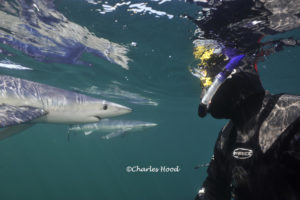
Sleek, beautiful blue sharks inhabit waters around the world and are highly inquisitive, making for a fun dive
Where: Cornwall, England
Southwest Cornwall is one of the best places to see blue sharks as they congregate in large numbers there and tend to stay around dive boats for a few hours at a time. They offer great shark diving for divers and non-diver alike as most blue shark dives in Cornwall are in fact snorkeling trips.
Details: Blue shark diving off Cornwall isn’t for those who get easily seasick as the conditions can be variable. Water temperatures are chilly, from 45 to 61 F (7 to 16 C). Visibility is typically 26 to 100 feet (8 to 30 m). A warm wetsuit or drysuit, hood, gloves and boots are essential. You needn’t have any dive experience for blue-shark snorkeling safaris off Cornwall.
When to go: The blue sharks are present from July through mid-October each year. Charles Hood runs a number of expeditions each year, though you must charter the whole boat.
14. Mako sharks
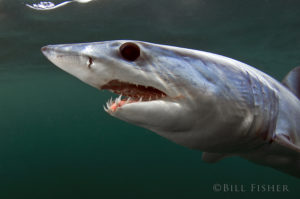
Mako sharks live in oceans around the world; the short-finned mako is fastest fish in the sea. They’re bold, swift and encounter makes for a fascinating dive.
Where: Rhode Island, United States
Rhode Island offers great mako- and blue-shark diving each summer and both types of sharks are often present on dives. There are options for everyone; with cage diving, freediving and snorkeling on offer to experience these unique sharks. Rhode Island Shark Diving runs cage-free open-water freediving trips each year from June through September.
Details: Water temperatures ranges from 60 to 70 F (15 to 21 C) during the shark-diving season of June to September. Visibility varies from 40 to 80 feet (15 to 25 m). Cage dives occur at the surface or in up to 7 feet (2 m) of water. Anyone who wants to be in a cage, even at the surface, must be certified.
When to go: The mako sharks are present from June to September each year.
15. Basking sharks
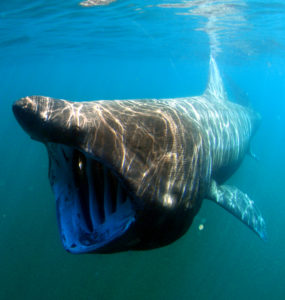
Basking sharks, often seen with giant mouths agape, inhabit the waters off Scotland and Cornwall. Although their mouths are up to 3 feet wide (1 m), divers have nothing to fear from these filter feeders.
Where: The Hebrides Islands, Scotland
The clear blue waters of the Hebrides in Scotland are ideal for snorkeling with basking sharks. You can also swim with seals, dive local sites and check out other local wildlife.
Details: Water temperature ranges from 13 to 18 °C (55 – 65 °F) during the shark season of April to October and a thick wetsuit, plus gloves, hood and booties, are essential. Water visibility can reach up to 30 meters (100 feet) at the Hebrides though the influx of plankton can reduce that significantly. Basking shark encounters are suitable for non-divers.
When to go: Basking shark safaris take place from April to October each year.
16. Lemon sharks
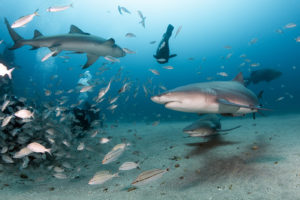
Lemon sharks, thusly named because of the distinctive yellow tinge of their skin, can grow over 13 feet (4 m). You’ll find them in both Atlantic and Pacific waters, but there’s one spot that offers the best chance for seeing them in large numbers.
Where: Jupiter, Florida
The waters off Jupiter teem with lemon sharks each winter, and divers can encounter up to 60 individual sharks during just one dive. It is the best place to experience lemon sharks in huge numbers.
Details: The winter water temperature off Jupiter is around 75 F (24 C) and cooler at depth. Lemon-shark dives can be at depths up to 100 feet (30 m), so bring a 5- to 7mm wetsuit, gloves and a hood. Nitrox is best for lemon-shark dives.
When to go: The lemon sharks are in Jupiter from December to late March each year.
17. Broadnose sevengill shark
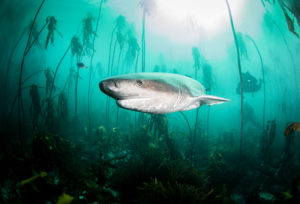
Broadnose sevengill sharks, also known as cow sharks, have been around since for over 150 million years. These are some of the most primitive sharks alive today, and very easy to dive with.
Where: Simons Town, South Africa
Divers can spot these prehistoric predators in the kelp forests off Simons Town, South Africa. The sharks grow up to 10 feet long (3 m) and approach divers closely as they swim among the kelp. Divers can also see endemic and go snorkeling with Cape fur seals.
Details: This shark dive is ideal for new divers as it occurs at a maximum of 40 feet (12 m). Water temperatures range from 54 to 65 F (12 to 18 C) and water visibility is generally 17 to 50 feet (5 to 15 m).
When to go: Diving with sevengill sharks is possible year-round.
18. Nurse sharks
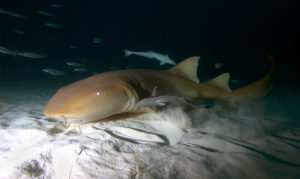
Encounters with sleepy, generally docile nurse sharks offer a great dive experience for everyone from newbies to experienced divers. You’ll find them in warm-water dive destinations around the globe.
Where: Ambergris Caye, Belize
Amergris Caye is the perfect location to enjoy Belize barrier reef diving, calm waters and abundant, friendly nurse sharks. Fishermen traditionally cleaned their catch in Shark Ray Alley, which is now home to large numbers of nurse sharks and stingrays.
Details: You’ll see nurse sharks both while diving and during dedicated snorkel trips to swim with them and stingrays. The water temperature is consistently warm, around 81 F (27 C) and visibility reaches 100 feet (30 m). Currents are mild on the whole and you don’t need any experience swim with the nurse sharks.
When to go: Nurse-shark diving is possible year-round, though hurricane season runs from July to September.
19. Leopard sharks
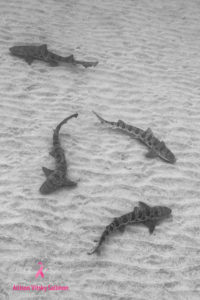
Leopard sharks — not to be confused with zebra sharks — live only off the coast of California. Dives with them are accessible to all.
Where: La Jolla Cove, California
The beautiful kelp forests of La Jolla Cove are famous for their ethereal beauty and are a snorkeler’s and diver’s paradise. Sea lions, fish life and leopard sharks abound. You can easily see the sharks via a shore dive, and they offer great photographic opportunities famed among the kelp and above sandy bottoms.
Details: The sharks live shallow waters during the summer and no diving experience is needed. The water temperature in summer reaches 21 °C (70 °F) and the waters are generally calm.
When to go: Leopard sharks are present at La Jolla from May to October each year.
20. Salmon sharks
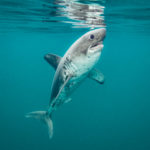
The final entry on our list features another shark you can see only one place in the world — salmon sharks in Alaska.
Where: Prince William Sound, Alaska
These great-white-shark lookalikes congregate in the sound to feast on pink salmon each year and you can snorkel or free-dive with them. The waters might be chilly but swimming with these large sharks is unforgettable. Divers can also search for Pacific sleeper sharks and dive with enormous blooms of moon jellies.
Details: The water temperature is a chilly 50 to 60 F (10 to 16 C) even at the height of summer. You’ll want at least a 7 mm wetsuit with hood and gloves, but ideally a drysuit. Warm clothing is a must for topside adventures as the summer can still be cool in Alaska.
When to go: Salmon sharks congregate in Prince William Sound for a short time only during the Alaskan summer.
By writers from liveaboard.com
The post The World’s Top 20 Shark Dives appeared first on Scuba Diver Life.
from Scuba Diver Life https://ift.tt/2uFMIPz
No comments:
Post a Comment